Children’s Health and UT Southwestern Break Ground on New Dallas Pediatric Campus; Announce $100 Million Donation from…
How Public-Private Partnership Can Improve Out-Of-School-Time in Dallas
Spring Break Highlights Need for More Strategic Support at District, City and State Levels to Provide Working Parents with OST Options
It’s important to note the difference between traditional childcare and out-of-school-time (OST) programs. OST programming is aimed at extending a learning environment outside of school to improve a student’s academic skills, and provide enrichment content and opportunity for exploration. In contrast, traditional childcare functions as babysitting where the goal is simply to supervise children after school.
Spring Break for Dallas Independent School District is exposing many families to the reduced availability of out-of-school-time programs across Dallas.
Due to COVID-19, nearly all time has become out-of-school-time, and Dallas students are experiencing an unprecedented level of learning loss with DISD reporting 30 percent learning loss in reading and 50 percent learning loss in math (not to mention the social-emotional impact).
Due to extended time out of the classroom, and in some cases large periods of no schooling, learning loss has fueled a learning gap, which is the disparity between what a student has actually learned and what he or she was expected to learn at a particular age or grade level.
Out-of-school-time programs were a crucial piece of closing the learning gap, but there are 30 percent fewer OST programs in operation due to permanent COVID-related closures.
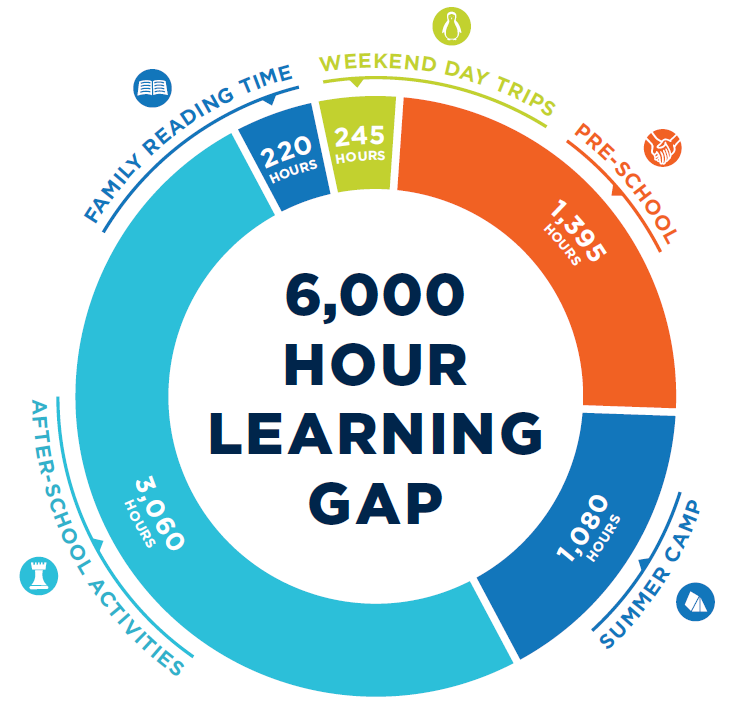
By sixth grade, low-income students have averaged 6,000 fewer hours of enrichment activities compared to middle-income students (Source: ExpandEDSchools).
The biggest casualties of OST program closures are children from low-income families residing in low-opportunity areas, who are disproportionately affected by learning loss. In fact, by sixth grade, low-income students have averaged 6,000 fewer hours of enrichment activities compared to middle-income students, with 70 percent attributed to lost after-school and summer opportunities.
Out-of-school-time programs are not only important for leveling the academic playing field, but the lack of quality after-school programming has direct negative consequences for economic growth, food security, and public safety.
It will take a combined effort of public-private funding and community-based creative solutions to combat the shortfall of out-of-school-time programs in Dallas County – especially for the over 100,000 low-income students.
The Shortfall
Even before COVID-19 forced the closure of so many out-of-school-time programs, Dallas County only had enough free or low-cost after-school seats to serve 17 percent of low-income students, according to Dallas Afterschool, a nonprofit organization that works to ensure all children have access to high-quality out-of-school-time programs.
Compounded with the year-long COVID-19 pandemic, there are even fewer out-of-school-time providers with reduced capacity due to social distancing protocols and income shortfalls paired with increased operating expenses.
Access to high-quality, after-school and summer programming has long been a challenge faced by Dallas’ working parents – especially those residing in low opportunity areas of the city.
The two major barriers to access are the students’ proximity to program sites, and the costs associated with attending after-school programs.
Addressing Proximity
The City of Dallas has more than 101,000 children who would be enrolled in an after-school program if one were available to them, a recently commissioned Dallas Afterschool survey found.
“We would love for all of our independent school districts and public charters to ensure that there was an after-school program on every elementary school campus. That’s not the case today,” said Christina Hanger, CEO of Dallas Afterschool.
In the 75217 zip code of South Dallas, known as Pleasant Grove, where 30 percent of children are raised by single mothers[i], there are 16 elementary schools, but only three offer on-site after-school programming, which is funded by the city and operated by Dallas Parks and Recreation.
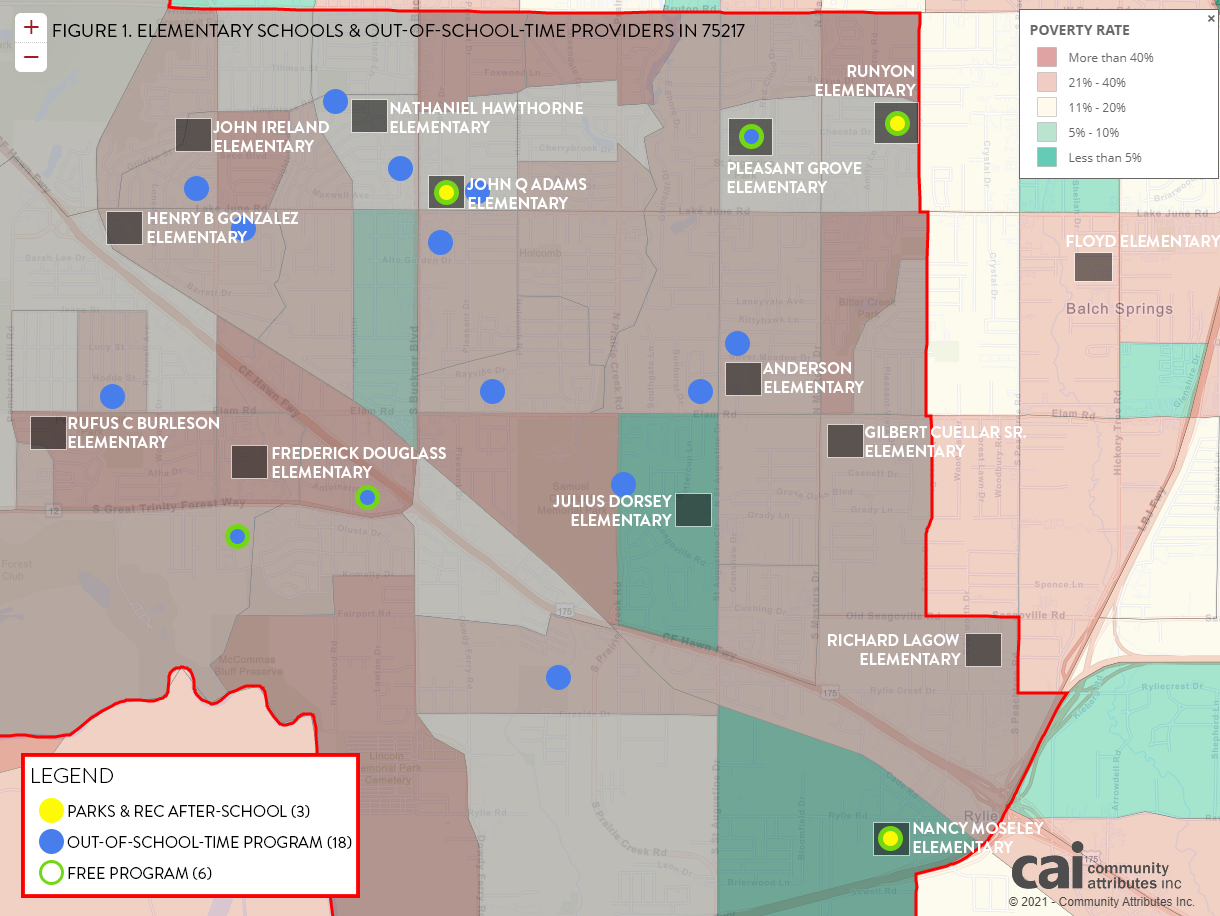
Figure 1. The out-of-school-time programs included on the map are limited to those after-school programs that appear on the Dallas Afterschool Program Finder for the zip code of 75217. After-school programming supported by Dallas Parks & Rec is provided at Runyon, Adams and Moseley Elementary Schools. Pleasant Grove Elementary hosts an after-school program unrelated to the Parks & Rec program (Map provided by Casey Family Programs. Schools and OST programs added by The Rees-Jones Foundation and are approximate).
As Hanger mentioned, Dallas Afterschool is encouraging the district to provide an after-school and summer program at all public elementary and middle schools, especially in low opportunity communities.
A recent study commissioned by Dallas Afterschool identified the ten highest-priority neighborhoods based on a combined weighted score of demographic factors such as after-school and school performance, neighborhood conditions, gentrification, and access to public transportation.
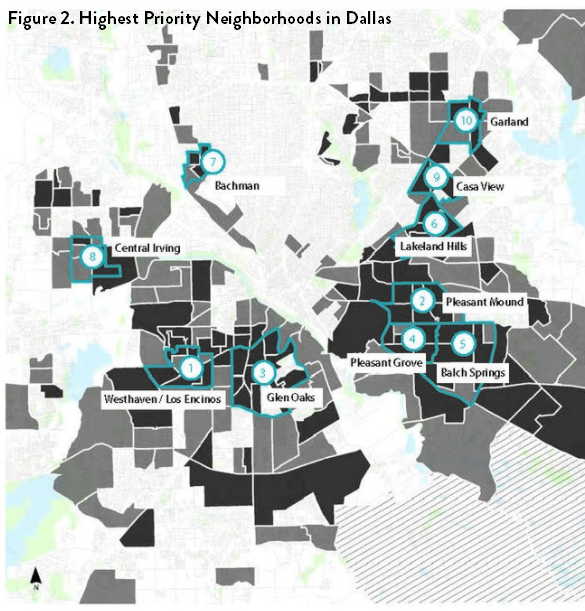
Figure 2. Dallas Afterschool has identified 10 areas of priority within Dallas County that are in high need of after-school solutions (Source: Dallas Afterschool 2017 Afterschool Access Map).
In the majority of the top ten highest-priority neighborhoods (identified in figure 2), there are only enough free or low-cost OST seats to serve 10 percent of the student population.
In Pleasant Grove, for instance, 380 seats exist to serve 8,500 children under the age of 14, or 4 percent of the eligible population.
Another option, Dallas Afterschool suggests, is to include out-of-school-time (after-school and summer) programming in all Community Hubs.
In November 2020, Dallas voters approved Proposition A, which includes $40 million to fund the creation of four Community Hubs in Pleasant Grove, West Dallas, South Dallas, and Oak Cliff. These communities have little access to OST programs – with Pleasant Grove representing the largest OST desert in Dallas County.
The proposed Community Hubs, which are still in the planning phase, will not only address out-of-school-time programming, but also serve as a dedicated space for community organizations to provide programming such as workforce/vocational training, trauma and therapy services, legal services, and housing resources. The proposed hubs will also feature health clinics, wellness centers, pharmacies, community closets and food pantries.
It’s worth noting that within the Spruce High School Feeder Pattern (figure 3), where the Pleasant Grove Community Hub is proposed, there are 10 public elementary schools, of which one currently provides after-school programming on-site.
There is a need, as voiced by the Pleasant Grove community, for adaptable OST programs available after-school as well as during the weekend and summer. Most after-school programs operate during the week from 3 to 6 p.m. For parents – especially single parents – who don’t work the classic 9 to 5 shift, the traditional hours of operation for OST programs don’t meet their needs.
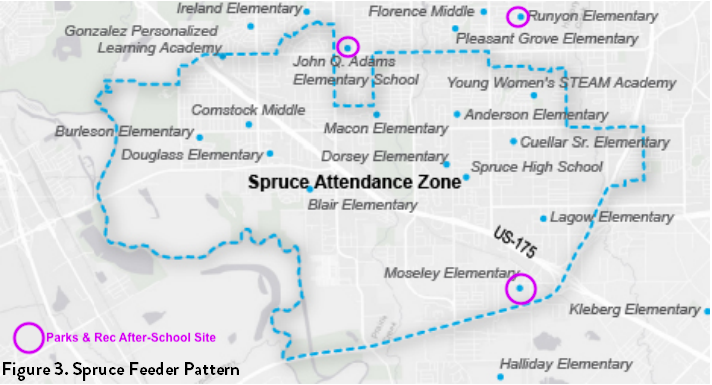
Figure 3. Dallas Parks & Rec After-School sites within and around the Spruce Feeder Pattern (Map provided by Child Poverty Action Lab. After-school sites added by The Rees-Jones Foundation).
But access to high-quality, out-of-school-time programming is more than a problem of convenience – it’s also a matter of information availability, which is why Dallas Afterschool is focused on providing parents with the information necessary to make the best OST decisions for their children.
As such, Dallas Afterschool recommends that Texas Health and Human Services provide an easily accessible online resource that publicly displays all after-school and summer programs, so that parents can find all licensed and state-exempt[ii] out-of-school-time facilities in their community.
Addressing Cost
The second barrier to high-quality, OST programming is cost. As a point of reference, fee-based, after-school care in Dallas averages $120 per week, or $4,300 per year, which is higher than the state average of $82 per week, and even higher than the Los Angeles average of $90 per week.
To begin to meet the demand, Dallas would need approximately $30 million each year to provide enough resources for the city’s children and to restore after-school programs to pre-pandemic levels, said Hanger, also noting that Dallas has lost about 45,000 after-school seats during the COVID-19 pandemic.
Unfortunately, there isn’t a lot of financial support for out-of-school-time programs.
However, the City of Dallas has, as recent as the summer of 2019, allocated additional funds for out-of-school-time programs via its general fund budget.
As the FY 19-20 City of Dallas budget was being crafted, the Mayor’s Task Force on Safe Communities found “several neighborhood groups and Task Force members have specifically been calling for increasing out of school time opportunities that give kids positive activities to focus on.”
This resulted in $975,000 for the All Youth Access Passes[iii] and $500,000 additional dollars for Parks and Recreation after-school programs.
There are now after-school programs at 20 DISD elementary schools that are available to students ages 6-12 as long as the child is enrolled in the program site school. Registration for these programs is limited and preference is given to families of low-income and single female head of households.
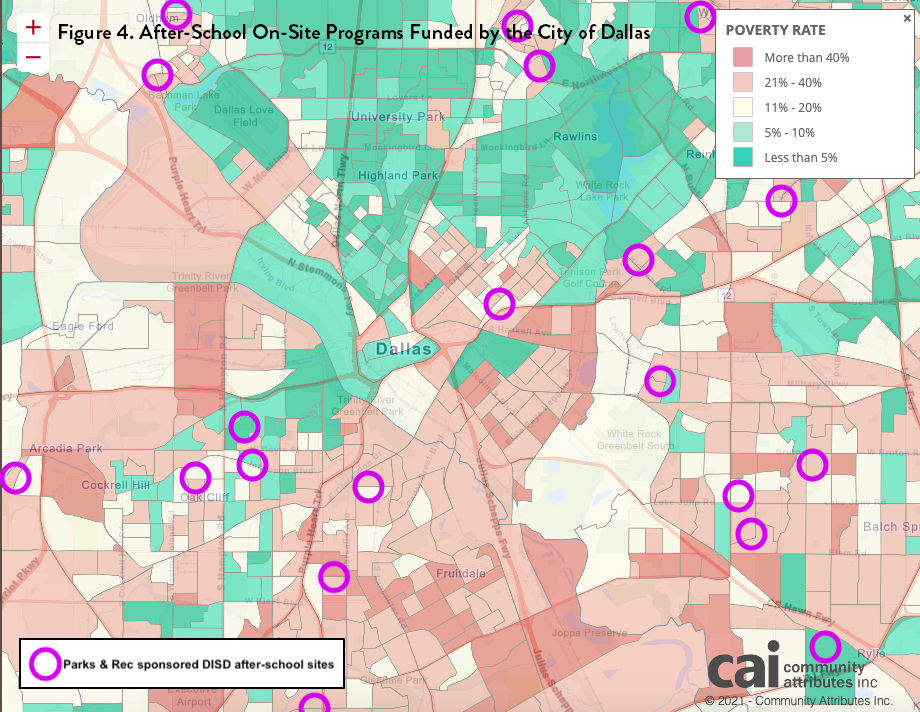
Figure 4. There are after-school programs supported by Dallas Parks and Recreation at 20 DISD elementary schools (Map provided by Casey Family Programs. After-school sites added by The Rees-Jones Foundation are approximate locations. A list of the participating schools can be found on the Dallas Parks & Rec website).
Three of the elementary schools in the 75217 zip code, which includes Pleasant Grove and the Spruce Feeder Pattern, host the Parks and Rec after-school program.
The combined efforts of local and state initiatives seek to empower parents to make better decisions for their children. By increasing availability of high-quality, out-of-school-time programs, Dallas can actively level the playing field for all children regardless of where they live.
Foundation Involvement
The Rees-Jones Foundation is working to provide children and youth with opportunities for enrichment and development. As such, the Foundation has supported organizations like Dallas Afterschool, which seeks to level the playing field for children of all races and economic backgrounds by building a sustainable ecosystem of high-quality out-of-school-time programs.
The Foundation seeks to expand access to OST programs in low-opportunity neighborhoods by targeting organizations that operate in West Dallas, South Dallas, and the larger southern sector.
Other providers of OST programming that the Foundation has supported include:
- Big Thought – its mission is to make imagination a part of everyday learning; its Thriving Minds program is a nationally recognized after-school program that focuses on social and emotional learning, creative exploration and expression, and an inclusive learning environment, all tied to academic outcomes
- Frazier Revitalization, Inc. – its after-school programming gets kids off the street and into positive activities, and provides consistent academic programming after school and in the summer to help close the achievement gap by building math and reading skills
- Project Transformation North Texas – its mission is to engage young adults in purposeful leadership and ministry, support underserved children and families and connect churches to communities in need; its afterschool program serves children grades 1-6
- The Salvation Army of Pleasant Grove – is committed to serving all who come to them; its after-school program transports children from their schools to its community center where it provides homework assistance, tutoring, recreations, and other activities.
- Voice of Hope Ministries – its mission is to extend the love of Jesus Christ by nurturing and training children through Biblical teaching, Christian character models, life skills coaching and educational support; its ASPIRE After-School Program provides opportunities for students’ personal growth and to develop meaningful relationships with peers and supportive, caring adults, and consists of activities such as tutoring, social-emotional learning, and Christian spiritual enrichment.
[i] US Census Bureau, American Community Survey (ACS) 5-year dataset, 2015-2019.
[ii] Many situations exist that allow OST providers to receive a licensing exemption. Educational facilities approved by Texas Education Agency, emergency shelters, and free or extremely low-cost programs run by nonprofit organizations can all receive official exemption. These unlicensed programs provide vital services for working and low-income parents, but are not listed on the HHS website, meaning parents may not understand the range of options available to them.
[iii] According to a City of Dallas memo, the City “funds an annual free youth access pass and supports additional scholarship opportunities for City of Dallas youth, age 5 to 17. Through this funding, youth will receive free and enhanced out of school time programming; i.e.: after school sports, golf instruction, tennis instruction, STEM programing and dedicated teen program initiatives and swim lessons.”
Share this post:
Category: Original Content
Collaboration Fuels Innovation By Sara Meyers, Communications Specialist In the philanthropy space, one of the values we…
Veterinary Services That Change Communities By Lynn Gibson, Senior Program Officer On August 30th, while most of…

